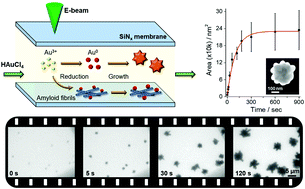Shape-controlled synthesis and in situ characterisation of anisotropic Au nanomaterials using liquid cell transmission electron microscopy†
Abstract
Understanding the mechanisms behind crystal nucleation and growth is a fundamental requirement for the design and production of bespoke nanomaterials with controlled sizes and morphologies. Herein, we select gold (Au) nanoparticles as the model system for our study due to their representative applications in biology, electronics and optoelectronics. We investigate the radiation-induced in situ growth of gold (Au) particles using liquid cell transmission electron microscopy (LCTEM) and study the growth kinetics of non-spherical Au structures. Under controlled electron fluence, liquid flow rate and Au3+ ion supply, we show the favoured diffusion-limited growth of multi-twinned nascent Au seed particles into branched structures when using thin liquid cells (100 nm and 250 nm) in LCTEM, whereas faceted structures (e.g., spheres, rods, and prisms) formed when using a 1 μm thick liquid cell. In addition, we observed that anisotropic Au growth could be modulated by Au-binding amyloid fibrils, which we ascribe to their capability to regulate Au3+ ion diffusion and mass transfer in solution. We anticipate that this study will provide new perspectives on the shape-controlled synthesis of anisotropic metallic nanomaterials using LCTEM.



 Please wait while we load your content...
Please wait while we load your content...
